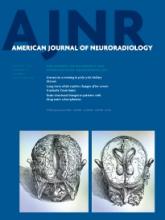Abstract
BACKGROUND AND PURPOSE: A recent study identified a preprocedural P2Y12 reaction units value of <60 or >240 as a strong independent predictor of perioperative thromboembolic and hemorrhagic complications after treatment of cerebral aneurysms with the Pipeline Embolization Device. This study aimed to determine whether a last-recorded P2Y12 reaction units value of <60 or >240 predicts thromboembolic and hemorrhagic complications up to 6 months after treatment of cerebral aneurysms with the Pipeline Embolization Device in the same patient cohort.
MATERIALS AND METHODS: We recorded patient and aneurysm characteristics, P2Y12 receptor antagonist administered, P2Y12 reaction units value with VerifyNow, procedural variables, and thromboembolic and hemorrhagic complications up to 6 months after Pipeline Embolization Device procedures at our institution during an 8-month period. Complications causing a permanent disabling neurologic deficit or death were considered major. Multivariate regression analysis was performed to identify independent predictors of thromboembolic and hemorrhagic complications.
RESULTS: Forty-four patients underwent 48 Pipeline Embolization Device procedures at our institution during the study period. There were 11 thromboembolic and hemorrhagic complications up to 6 months after treatment in our cohort (22.9%), 5 of which were major (10.4%). A last-recorded P2Y12 reaction units value of <60 or >240 was the only independent predictor of all (P = .002) and major (P = .03) thromboembolic and hemorrhagic complications in our cohort. Most patients (71%) required, on average, 2 adjustments to the dose or type of P2Y12 receptor antagonist to remain within the 60–240 target P2Y12 reaction units range.
CONCLUSIONS: In our cohort, a last-recorded P2Y12 reaction units value of <60 or >240 was the only independent predictor of all and major thromboembolic and hemorrhagic complications up to 6 months after Pipeline Embolization Device procedures.
ABBREVIATIONS:
- DAT
- dual antiplatelet therapy
- ICH
- parenchymal intracerebral hemorrhage
- PED
- Pipeline Embolization Device
- PRU
- P2Y12 reaction units
- © 2014 by American Journal of Neuroradiology
Indicates open access to non-subscribers at www.ajnr.org












